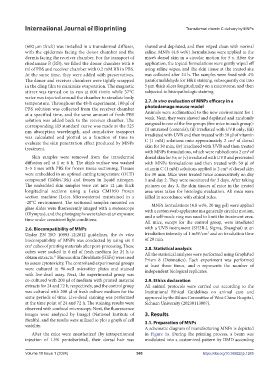Page 368 - IJB-10-1
P. 368
International Journal of Bioprinting Transdermal vitamin C delivery by MNPs
(600 µm thick) was installed in a transdermal diffuser, shaved and depilated, and then wiped clean with normal
with the epidermis facing the donor chamber and the saline. MNPs (4.8 wt%) formulations were applied to the
dermis facing the receiver chamber. For the transport of mice’s dorsal skin in a circular motion for 5 s. After the
rhodamine B (RB), we filled the donor chamber with 6 application, the topical formulations were gently wiped off
ml of PBS and receiver chamber with 0.2 mM RB in PBS. using saline wipes, and the skin tissue at the treated site
At the same time, they were added with preservatives. was collected after 24 h. The samples were fixed with 4%
The donor and receiver chambers were tightly wrapped paraformaldehyde for H&E staining, subsequently cut into
in the cling film to minimize evaporation. The magnetic 5 μm thick slices longitudinally on a microtome, and then
stirrer was turned on to run at 600 r/min while 37°C subjected to histopathologic staining.
water was injected around the chamber to simulate body
temperature. Throughout the 48-h experiment, 100 µl of 2.7. In vivo evaluation of MNPs efficacy in a
PBS solution was collected from the receiver chamber photodamage mouse model
at a specified time, and the same amount of fresh PBS Animals were acclimatized to the new environment for 1
solution was added back to the receiver chamber. The week. Next, they were shaved and depilated and randomly
corresponding RB standard curve was made at the 525 assigned to one of the five groups (five mice in each group):
nm absorption wavelength, and cumulative transport (i) untreated (controls); (ii) irradiated with UVB only; (iii)
was calculated and plotted as a function of time to irradiated with UVB and then treated with 50 µl of vitamin
2
evaluate the skin penetration effect produced by MNPs C (1 mM) solutions onto approximately 2 cm of dorsal
treatment. skin for 30 min; (iv) irradiated with UVB and then treated
with MNPs formulations, which were rubbed onto 2 cm of
2
Skin samples were removed from the transdermal dorsal skin for 5 s; or (v) irradiated with UVB and pretreated
diffusion cell at 1 or 6 h. The skin’s surface was washed with MNPs formulations and then treated with 50 µl of
3–5 times with PBS for frozen tissue sectioning. Tissues vitamin C (1 mM) solutions applied to 2 cm of dorsal skin
2
were embedded in an optimal cutting temperature (OCT) for 30 min. Mice were treated twice consecutively on day
compound (Tablet-Tek) and frozen in liquid nitrogen. 1 and day 2. They were monitored for 3 days. After taking
The embedded skin samples were cut into 12 μm thick pictures on day 3, the skin tissues of mice in the treated
longitudinal sections using a Leica CM1950 frozen area were taken for histologic evaluation. All mice were
section machine (Leica Microsystems) maintained in a killed in accordance with ethical rules.
-20°C environment. The sectioned samples mounted on MNPs formulations (4.8 wt%, 20 mg gel) were applied
glass slides were fluorescently imaged with a stereoscope with a cotton swab applicator in a generally circular motion,
(Olympus), and the photographs were taken at an exposure and a self-made ring was used to limit the treatment area.
time under consistent light conditions.
All mice, except for the control group, were irradiated
2.6. Biocompatibility of MNPs with a UVB instrument (SH2B-J, Sigma, Shanghai) at an
2
Under EN ISO 10993-12:2012 guidelines, the in vitro irradiation intensity of 1 mW/cm and an irradiation time
biocompatibility of MNPs was conducted by using six 1 of 20 min.
cm cubes of printing materials after post-processing. These 2.8. Statistical analysis
3
cubes were soaked in 6 ml of fresh medium for 24 h to All the statistical analyses were performed using GraphPad
obtain extracts. Human skin fibroblasts (HSFs) were used Prism 8 (Dotmatics). Each experiment was performed
31
to assess cytotoxicity. The control and experimental groups at least three times, and n represents the number of
were cultured in 96-well microtiter plates and stained independent biological replicates.
with live-dead assay. Next, the experimental group was
co-cultured with 200 µl of medium with printed material 2.9. Ethics declaration
extracts for 24 and 72 h, respectively, and the control group All animal protocols were carried out according to the
was cultured with 200 µl of fresh culture medium for the Institutional Ethical Guidelines on animal care and
same periods of time. Live-dead staining was performed approved by the Ethics Committee of West China Hospital,
at the time point of 24 and 72 h. The staining results were Sichuan University (20230113007).
observed with confocal microscopy. Next, the fluorescence
images were analyzed by ImageJ (National Institute of 3. Results
Health), and the results were utilized to plot a graph of cell 3.1. Preparation of MNPs
viability.
A schematic diagram of manufacturing MNPs is depicted
After the mice were anesthetized (by intraperitoneal in Figure 1a. During the printing process, a beam was
injection of 1.5% pentobarbital), their dorsal hair was modulated into a customized pattern by DMD according
Volume 10 Issue 1 (2024) 360 https://doi.org/10.36922/ijb.1285

